In their second official appearance at a FIFA Women’s World Cup, Costa Rica have the opportunity to progress to the knockout stage for the first time.
In her eight-year tenure as head coach of Las Ticas, Amelia Valverde Villalobos has been a crucial element in developing women’s football in Costa Rica. Their two wins over Panama and Trinidad and Tobago were enough to guarantee a place at the highest international football stage.
The Costa Ricans have a difficult but not impossible job in Group C with a former World Cup winner in Japan, an emerging national team in Spain who have just lost one game in eleven and a debutant in Zambia. Throughout the year Costa Rica has been increasing their roster’s quality and at the moment they have players performing in the top European leagues like the women’s version of La Liga, Ligue 1 or even UEFA Champions League.
It will be interesting to observe how Amelia will combine her team’s ideas with the opponent that they are going to face. For instance, as we are going to develop further in this scout report, Costa Rica’s game plan is not constant as time goes by, increasing tactical uncertainty for their opponents.
In this tactical analysis, we’re going try to unveil Costa Rica’s predicted starting lineup as their attacking and defensive stages.
Predicted Starting XI
As we stated, Las Ticas are quite unpredictable concerning their tactical approach for each game, as a matter of fact, according to Wyscout they have almost the same amount of games playing in a 3-5-2 and in a 4-2-3-1.
However, during our analysis, we identify that in the last five games, they have played four times in a 3-5-2, we expect that Las Ticas present themselves in a defensive line with five elements.
Another factor that can contribute to this strategy is their opponents’ level, where playing with a five-woman backline significantly increases their odds of success while defending. For example, against Japan and Spain, Costa Rica are more likely to play in a 3-5-2, while against Zambia it is probable that the Costa Ricans expose themselves a bit more, playing in a 4-2-3-1.
This versatility concerning their game plan reveals maturity and quite good tactical knowledge by the Costa Ricans.
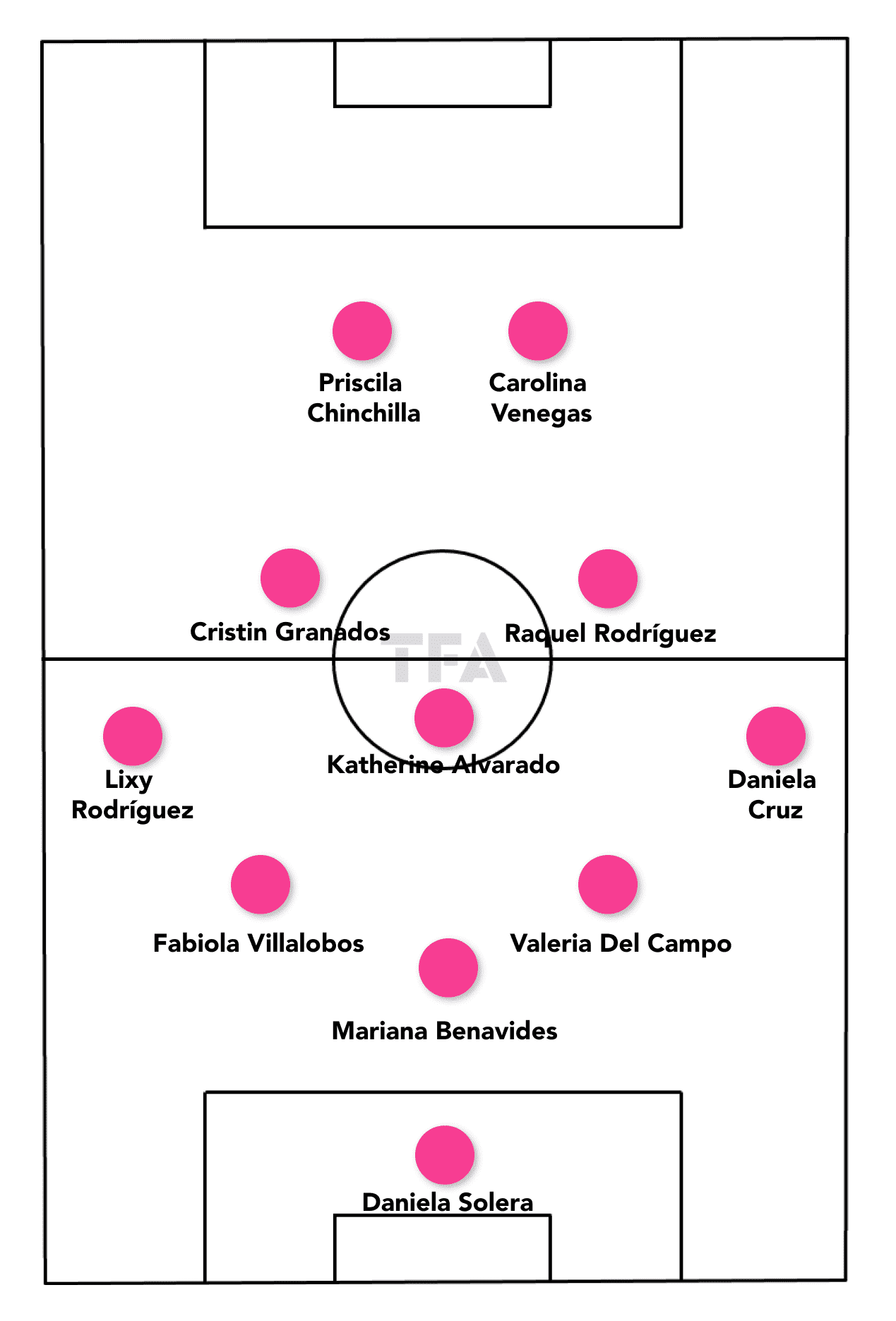
In goal, we foresee Daniela Solera as Amelia’s first choice due to her regularity in the World Cup qualifying games last year. We expect Mariana Benavides as the middle centre-back, with Valeria Del Campo who currently plays in C.F. Monterrey on her right side and the 25-year-old Fabiola Villalobos on her left.
The flanks are most likely to be occupied by two of the more experienced players of their squad, Daniela Cruz on the right and Lixy Rodríguez on the left.
In the middle, we expect Katherine Alvarado to perform as a single-pivot, while the most experienced and probably the captain in this year’s World Cup, Cristin Granados, together with one of the most influential players, Raquel Rodríguez, will most likely play on either side of her. When the Costa Ricans play in the 4-2-3-1 they use a double-pivot, and in that case, Cristin Granados would play alongside Katherine Alvarado.
The front two possibly will be Carolina Venegas as the more advanced option and as a centre forward one of the most exciting promises of Costa Rica women’s football: Priscila Chinchilla
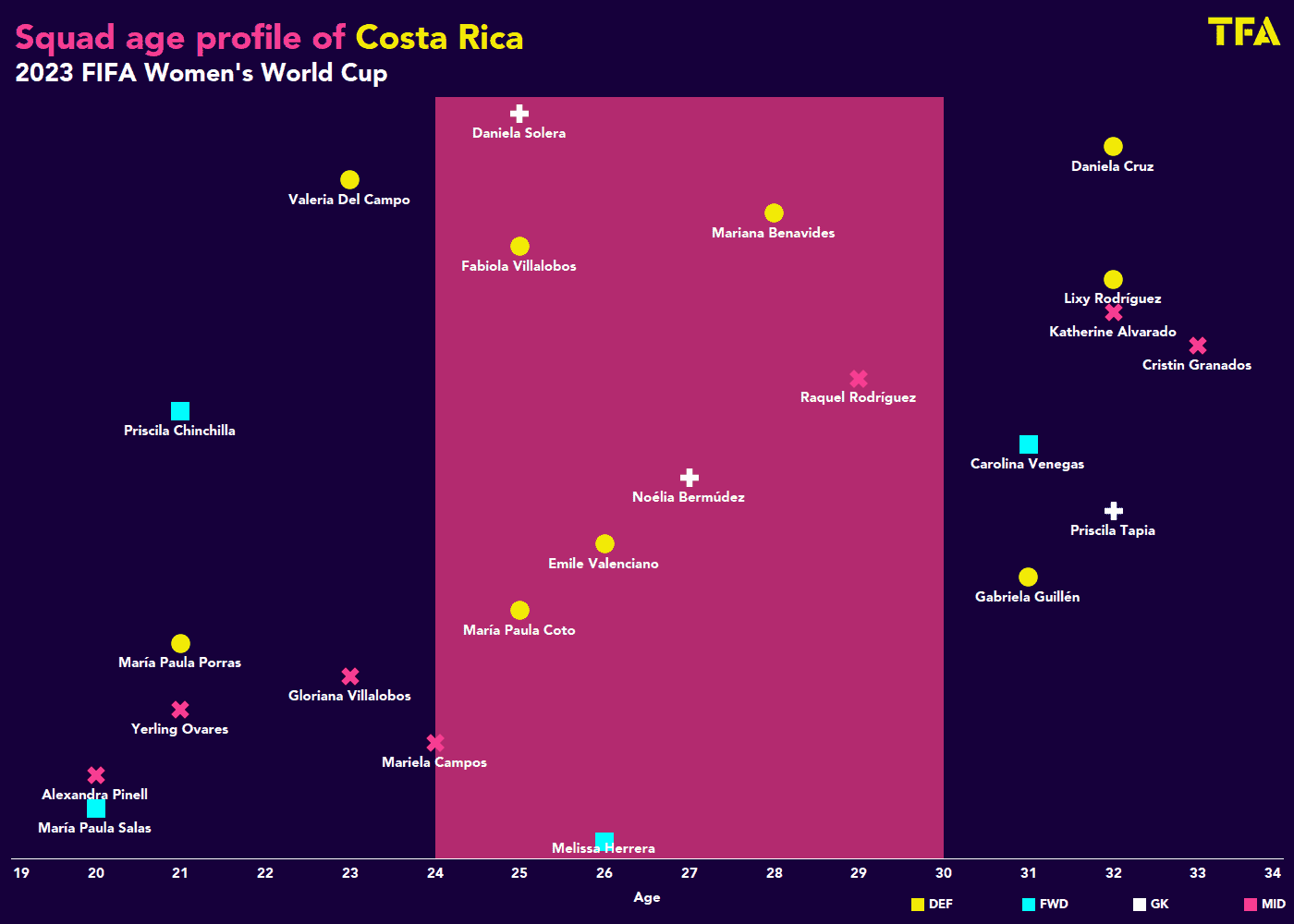
As we can see in the image, most of the players that we expect to be in their World Cup lineup are 28 years old or more. In fact, this starting XI has been the most used by the head coach in recent games, revealing a propensity to choose experienced players over younger players.
This approach can be very beneficial to Las Ticas because in these big competitions, it is necessary to have players capable of deciding fine details, and experience can be an important factor in this. For example, Cristin Granados, Raquel Rodríguez, Lixy Rodríguez and Katherine Alvarado are examples of elements that had several minutes in the 2015 World Cup and can play a decisive role in this year’s competition.
Attacking Phase
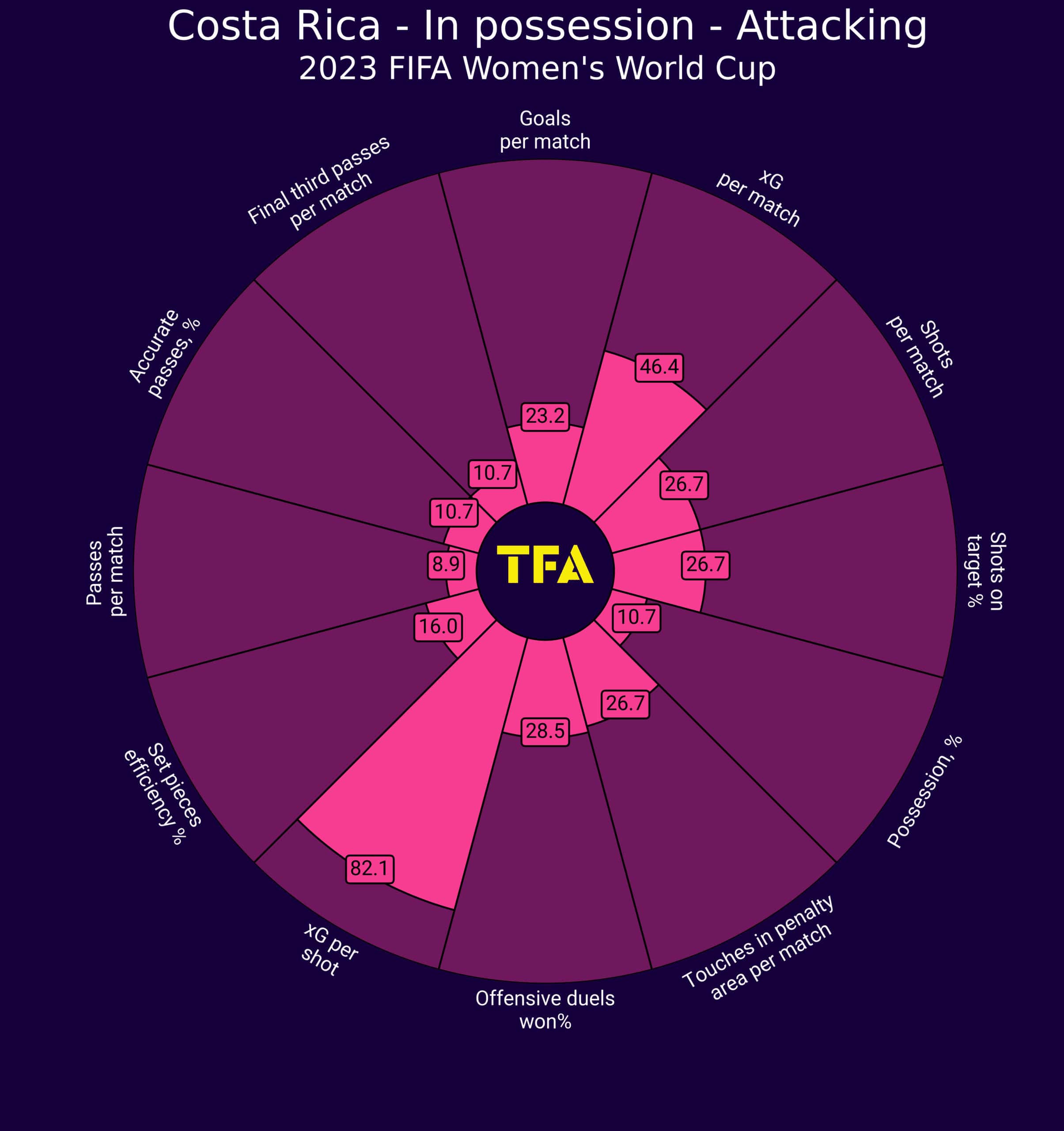
Looking at the radar above, it is noticeable that Costa Rica have difficulties in creating goalscoring opportunities while they are in possession, where they rank in the 10.7 percentile for final third passes per match. Yet, they present pretty good stats concerning the xG and xG efficiency, where they rank in the 46.4 and in the 82.1 percentile respectively.
Besides that, according to Wyscout, Las Ticas only finish their positional attacks with a shot approximately 22% of the time, while the average of their opponents is approximately 27%.
Concerning their build-up it is evident that it changes according to which formation the coach uses. With that said, we will analyse Costa Rica’s build-up in conformity with the formation that we think they are going to present: 3-5-2.
So, in this model, the full-backs are usually wide open and projected on the pitch. However, against big sides, it is probable that they descend on the pitch to support the centre-back.
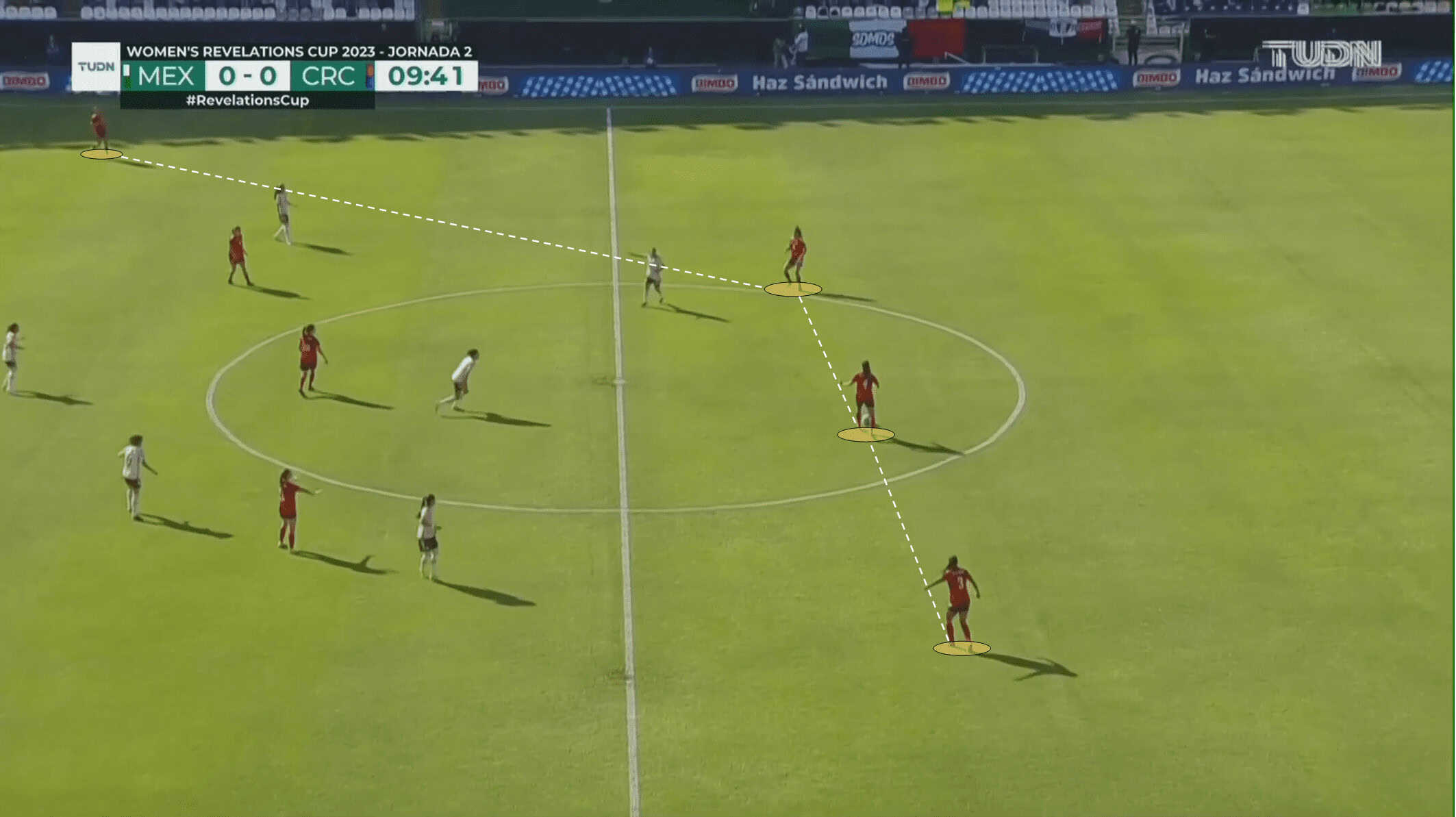
Amelia Valverde seemed to impose mobility in her team, and the coordination and articulation between the midfielder and the full-back are notable. In actual fact, as we can see in the below images when the full-back is low on the field, the midfielder gives a solution by dropping deeper and wider — or vice versa.
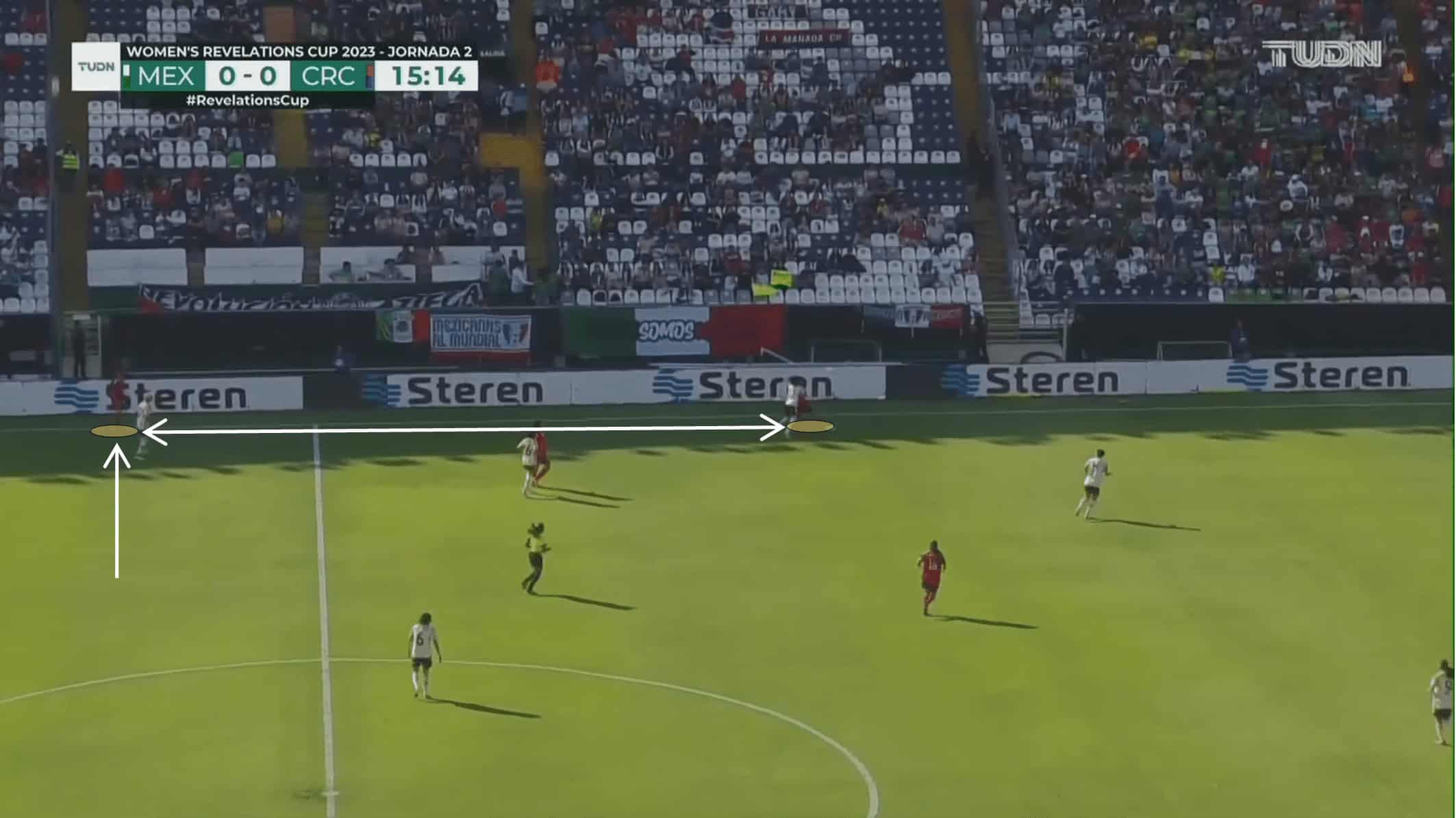
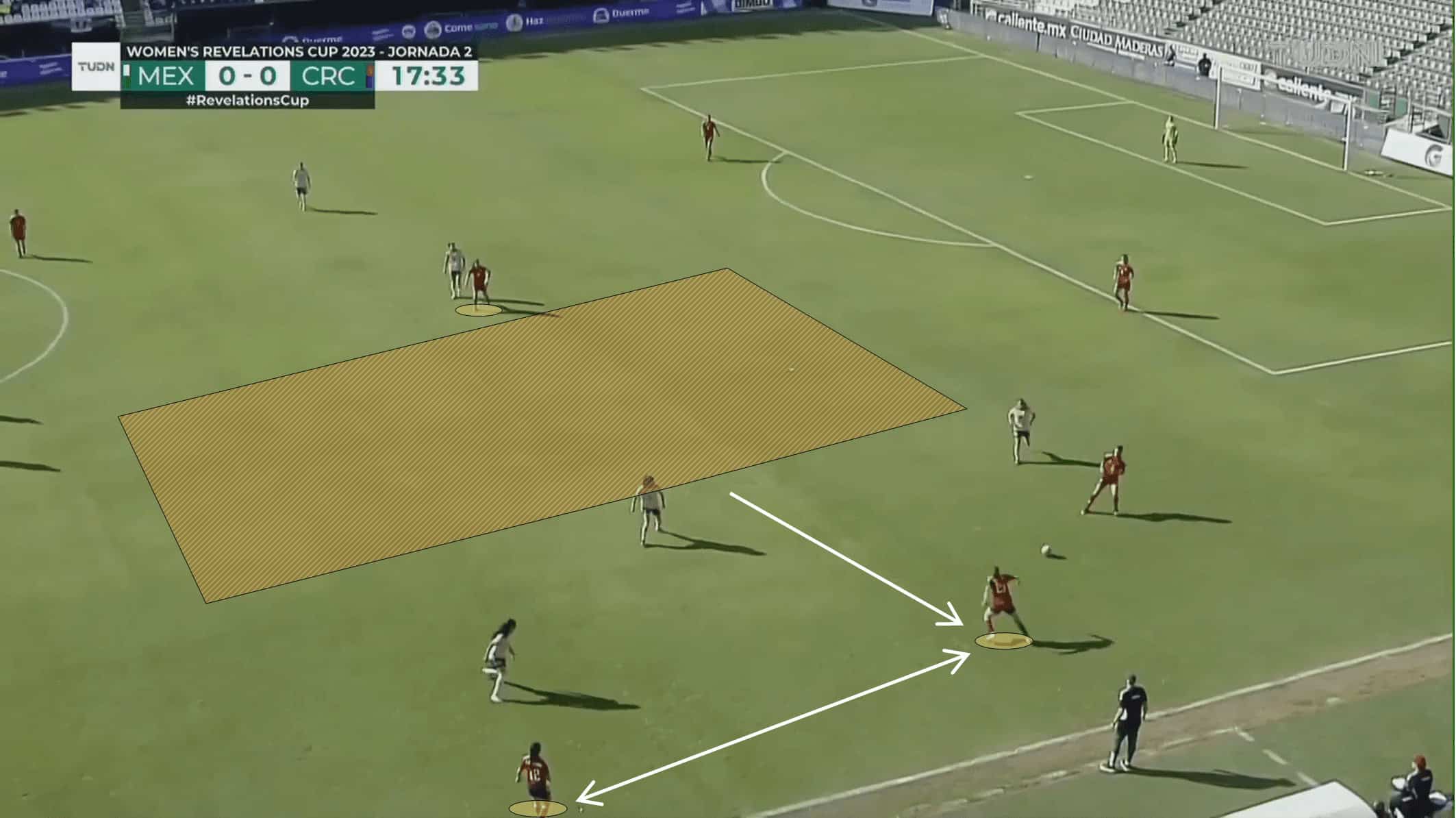
As we said before, Raquel “Rocky” Rodríguez is one of the most influential players within the Costa Rican squad. This status is not only due to her great technical ability in shooting, passing and dribbling but also due to her tactical understanding.
In fact, she is crucial to make the midfield-attack link, especially when she is playing as a centre forward, by exploring the space between the lines with the correct body shape.
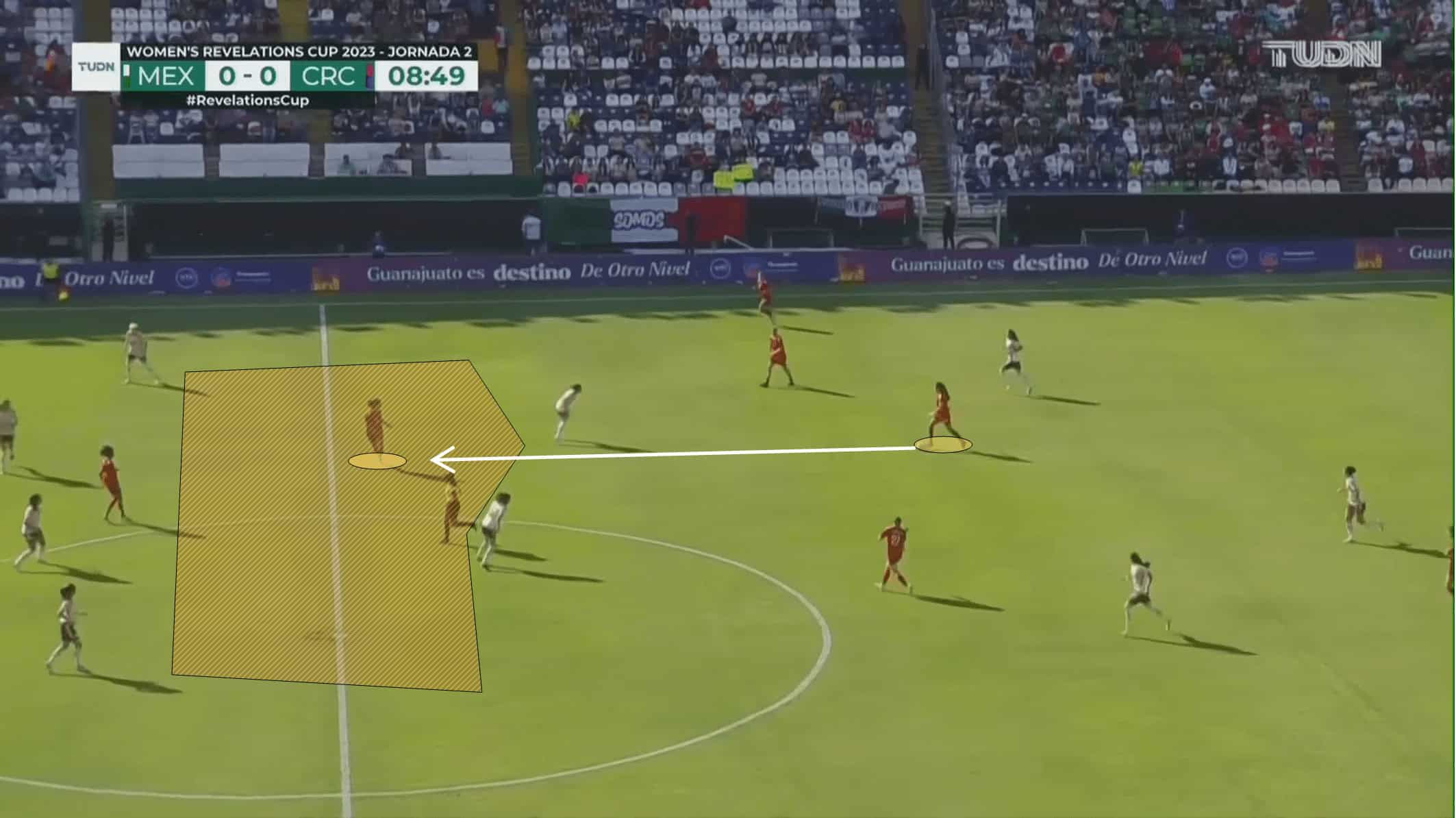
The coordination between the two lower midfielders during the build-up is also positive. In other words, they are rarely in the same line. This dynamic allows Costa Rica to create space to play in a zone which is normally occupied by a high volume of players.
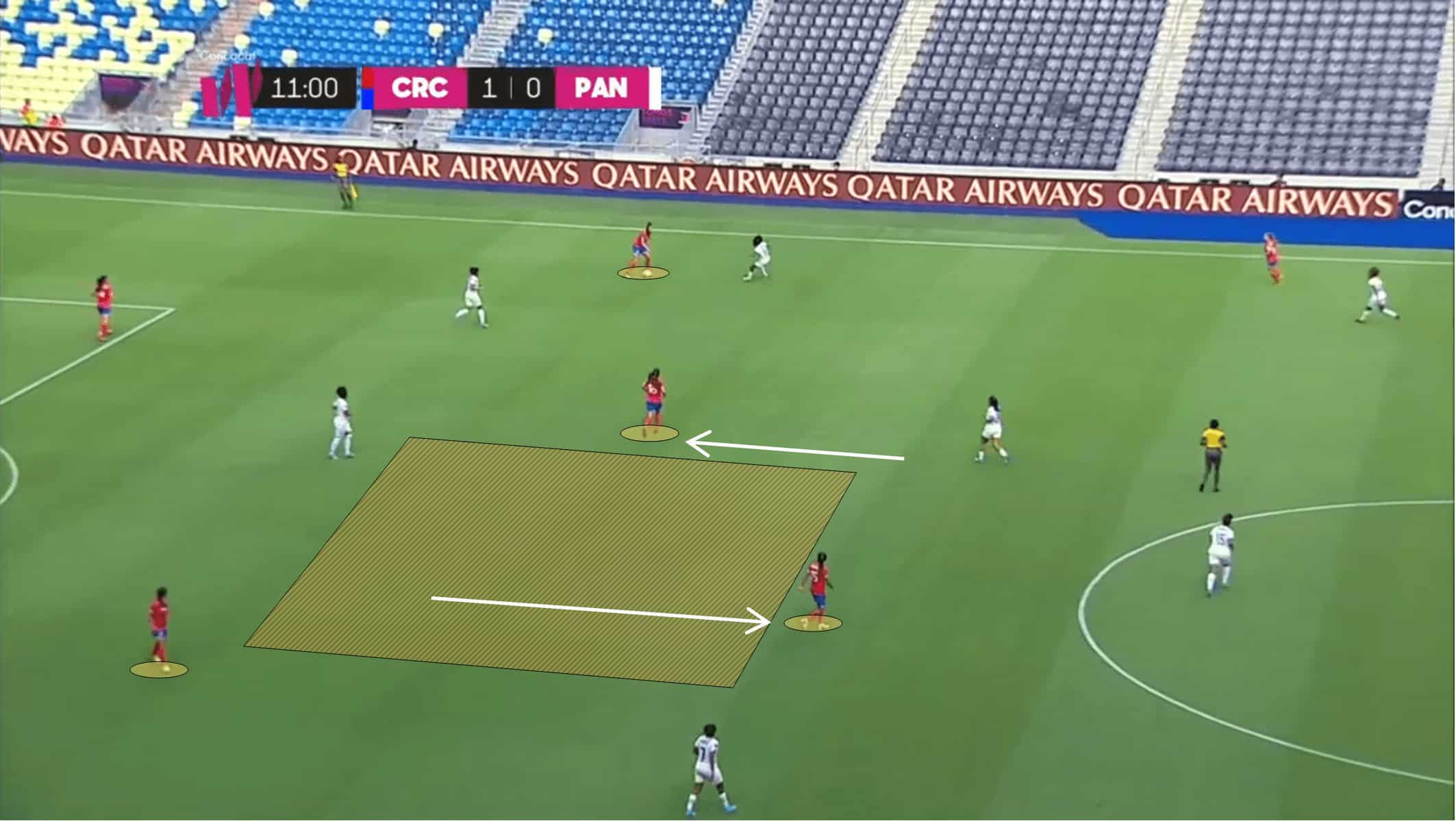
However, as we see it, one of the main reasons for Costa Rica’s struggle to create dangerous opportunities is due to their squad’s physique. This is visible, for example, in key passes into the depth, where the attackers are most of the time unable to give continuity to such a potential chance. This is because the players aren’t endowed with speed, although most of them can be explosive and agile.
Furthermore, the physique also negatively affects the team in crossing situations where the attackers are mostly unable to win the aerial duels. According to Wyscout from all the crosses made by Costa Rica, only 30% were accurate on average, while the average of their opponents succeeded approximately 40% of the time.
Defensive Phase
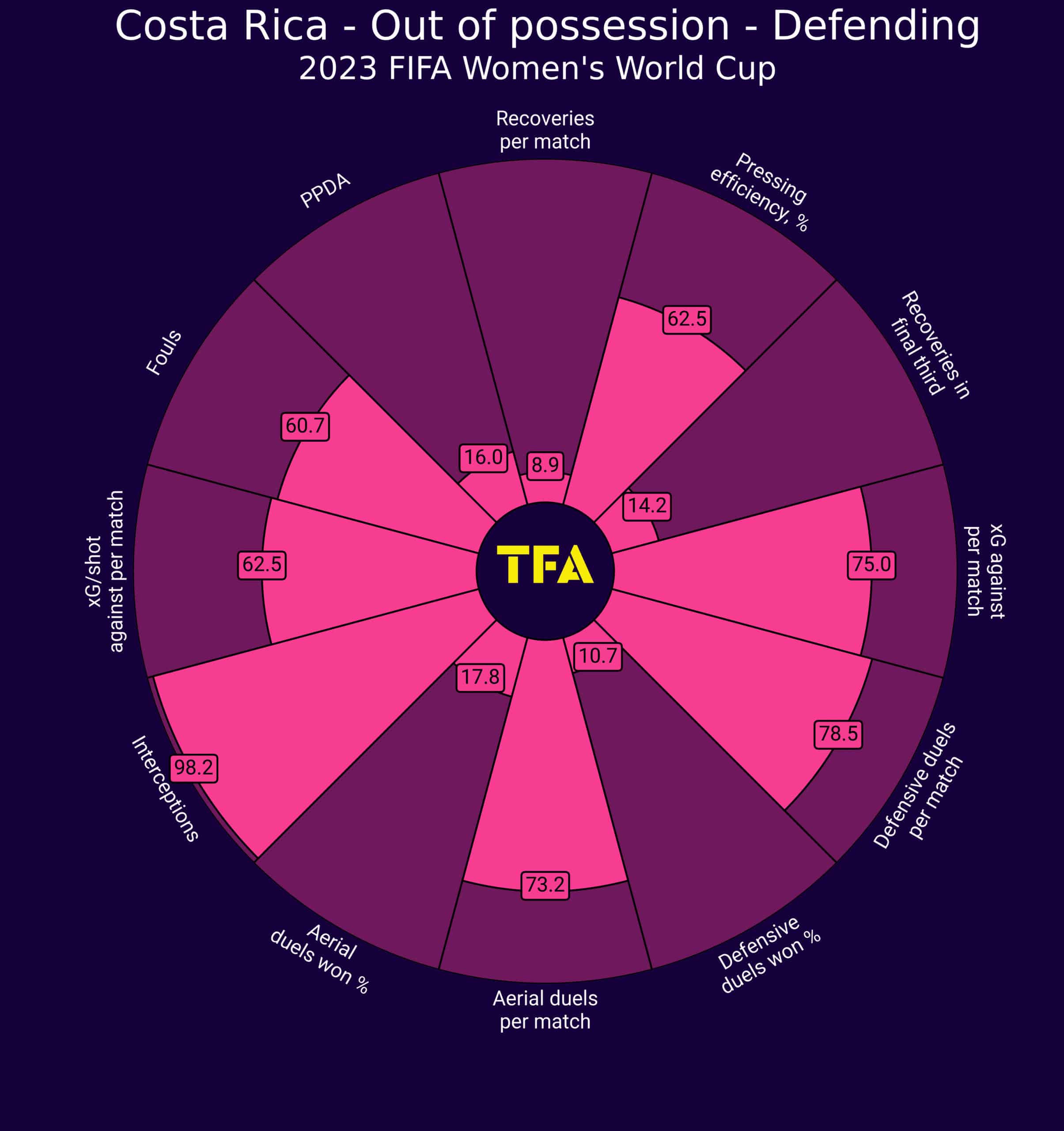
As a whole, their physical attributes affect their defensive process negatively due to the number of duels with the opposition during the game. For instance, as we can see above, they rank in the 10.7 percentile in the number of duels won % and in the 17.8 in the number of aerial duels won %.
Although a less physical team can mean difficulties in some defensive aspects, it is not a definitive indicator. For example, they rank in the 98.2 percentile in interceptions during the game, which is a very positive stat.
Normally, the Costa Ricans like to obstruct their opposition with a quite intense medium-high pressing block. However, as we’re going to see further, if the other side has more of the ball and they often built up successfully, their pressing intensity decreases during the game, and the centre-forward enters the midfield line, forming a 5-4-1.
In a 5-3-2 system against a four-women backline, the two forwards press the centre-backs and the side midfielders press the full-backs who stay near the backline holding the winger, increasing the team’s solidity and cohesion during the defensive process.
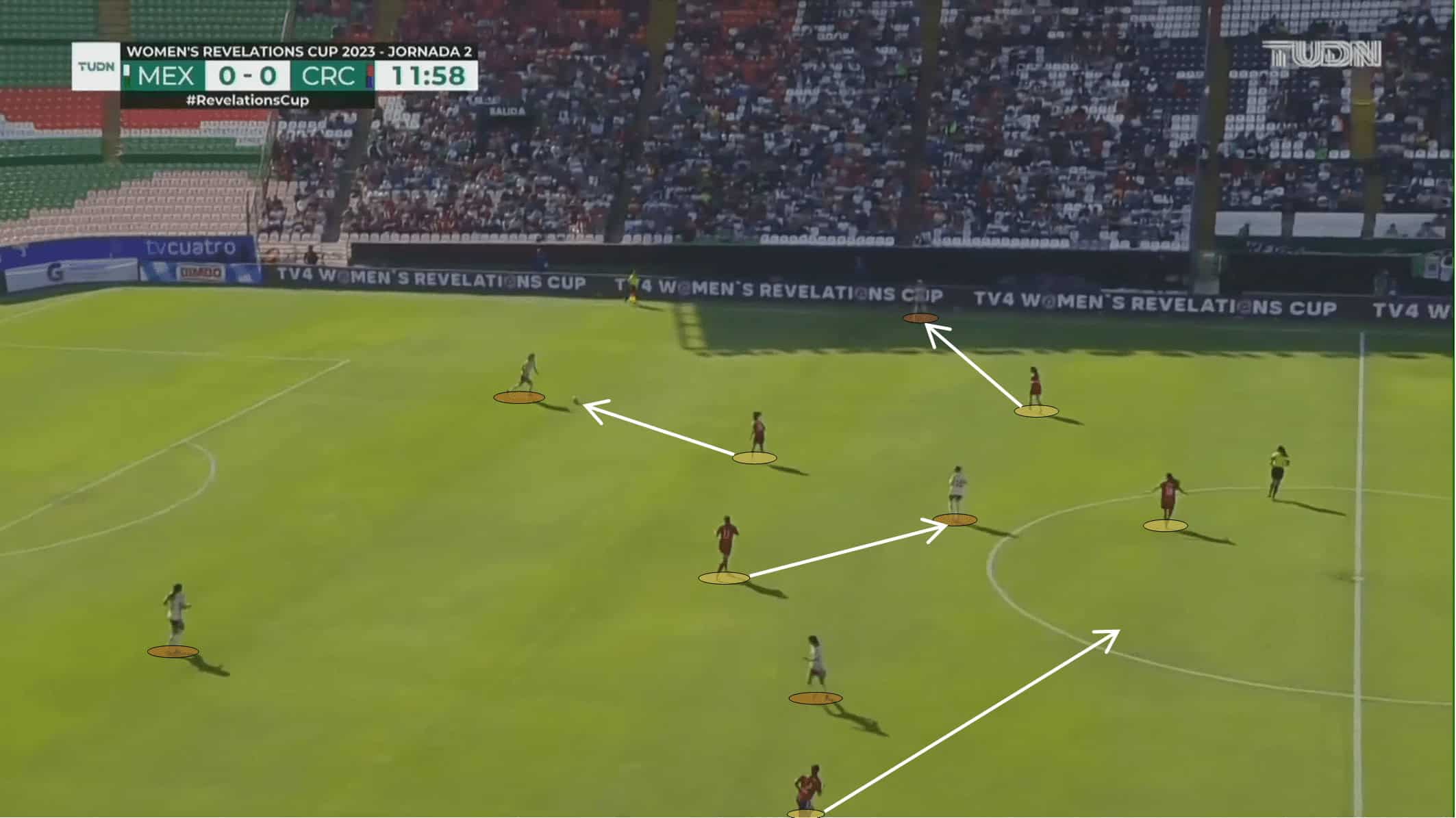
However, this kind of pressing plan is quite heavy for the midfielders due to the high distances that they have to cover while pressing the full-back and immediately positioning near the defensive midfielder when the ball is on the opposite flank.
With that said, there are situations when the other side’s full-back is open due to this physical stress, and as a consequence, their pressing strategy fails, as the following image illustrates.
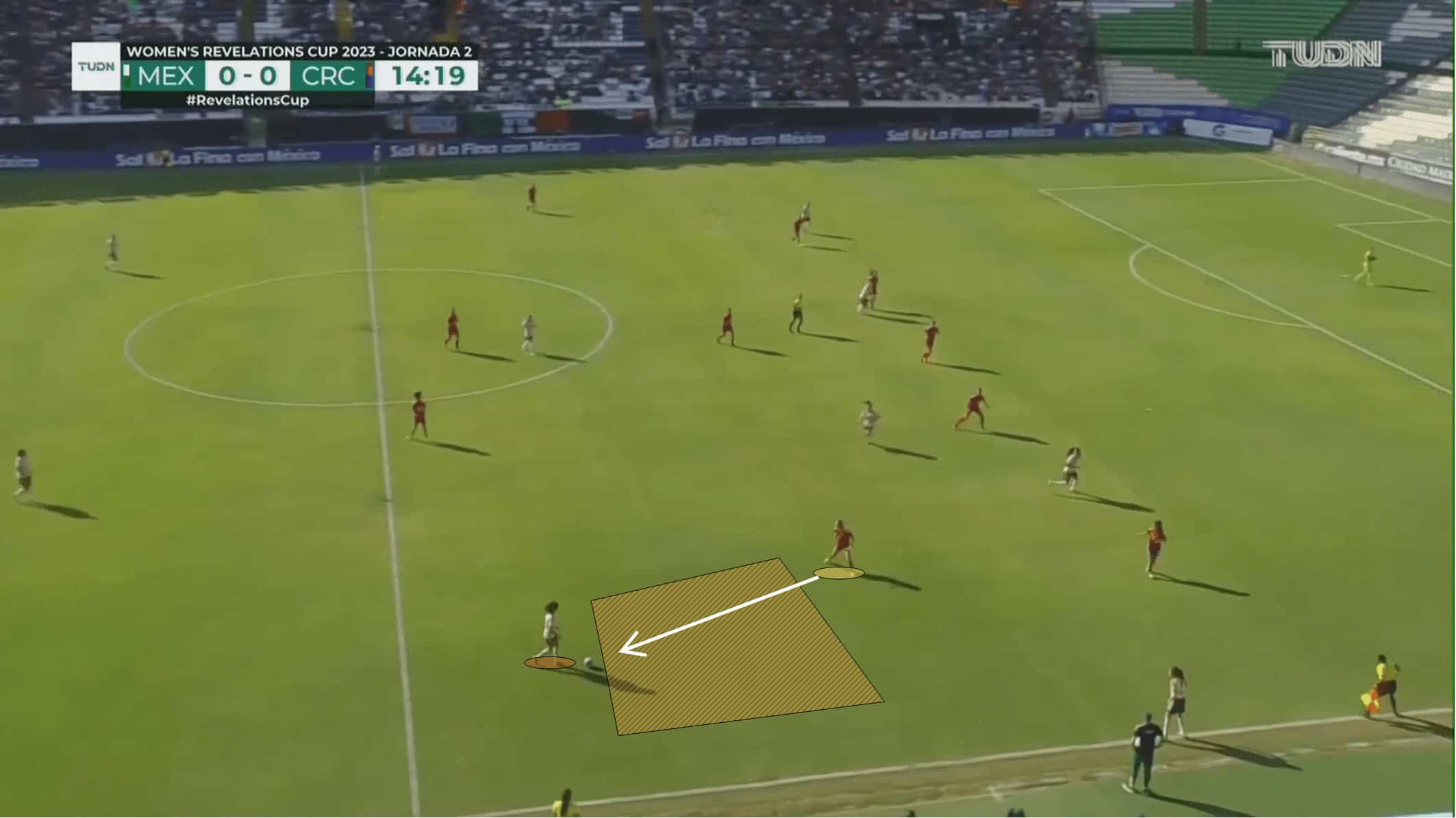
Yet, Las Ticas presented themselves as a relatively organised defensive team, with concrete and solid lines. They, and in particular the backline, also showed good body shape in uncovered ball situations, as we can see right below.
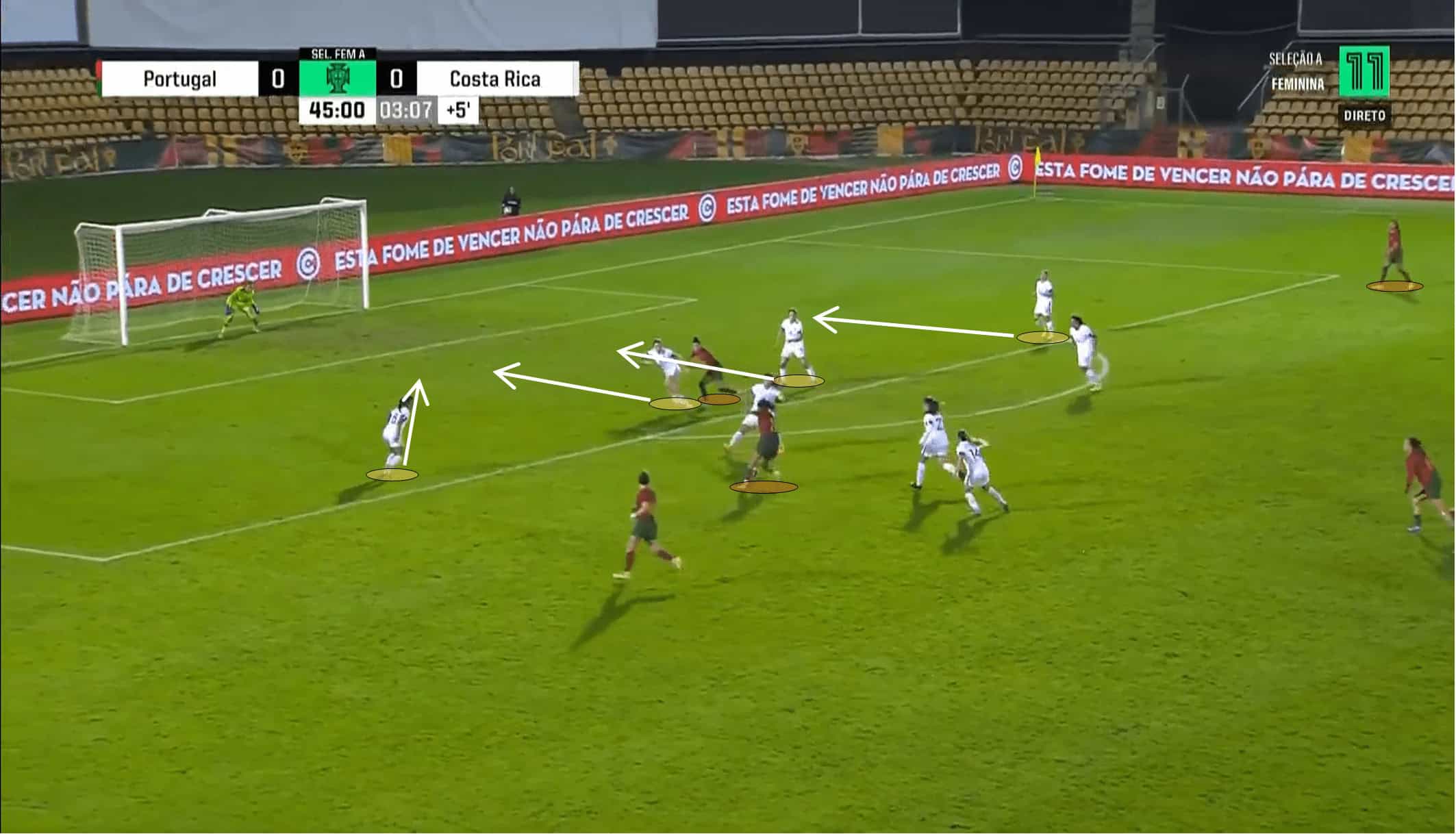
Even though Costa Rica are quite organised, there are still some cases where the backline presents some difficulties with controlling the depth as a result of some opposition movement.
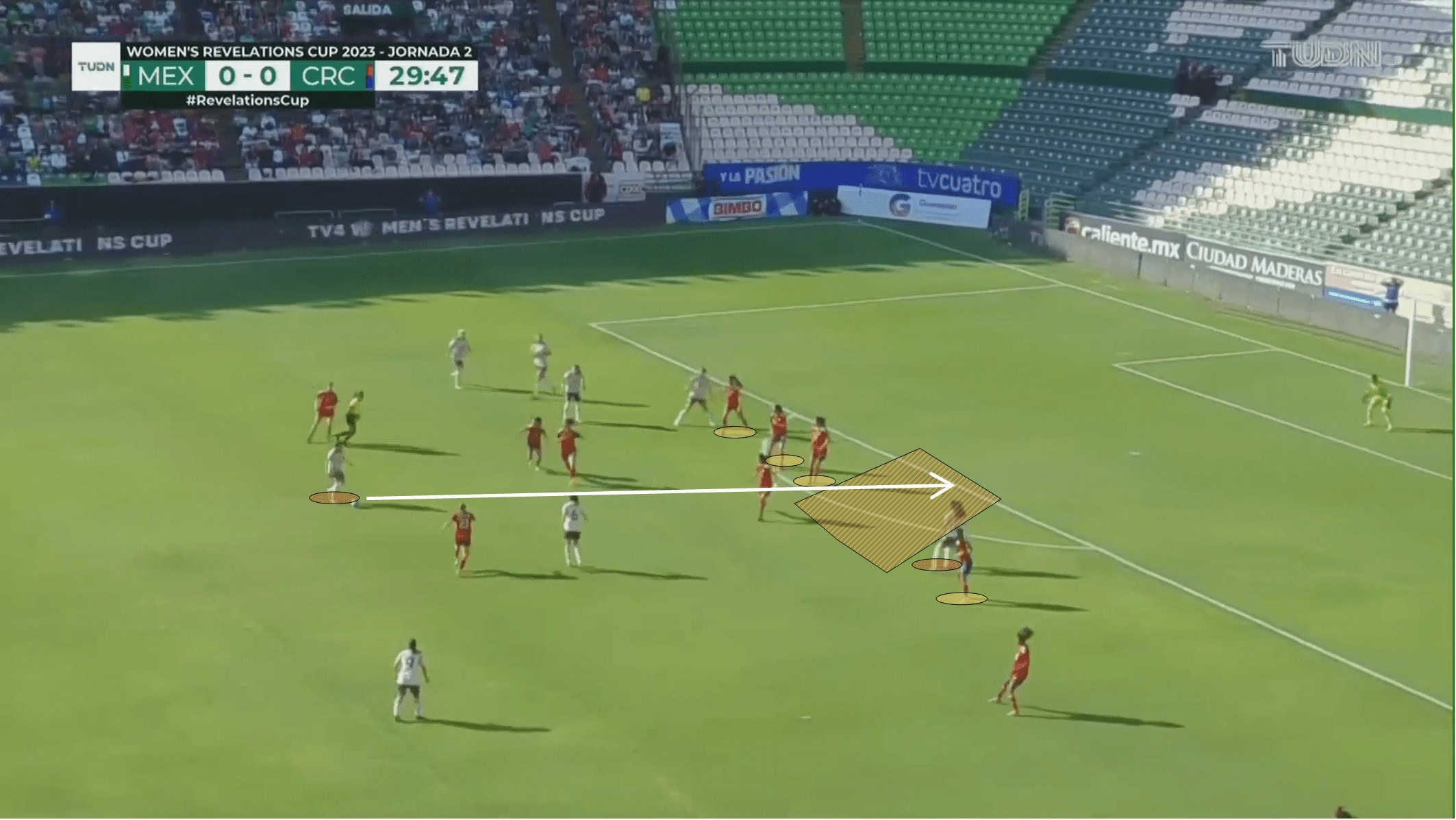
The centre-backs are intense without possession and often close the gap between their line and the midfield line. This action can be beneficial in order to limit the other team’s ability to play through them centrally. However, it also has its risks where, for example, it creates a big void behind the defensive line.
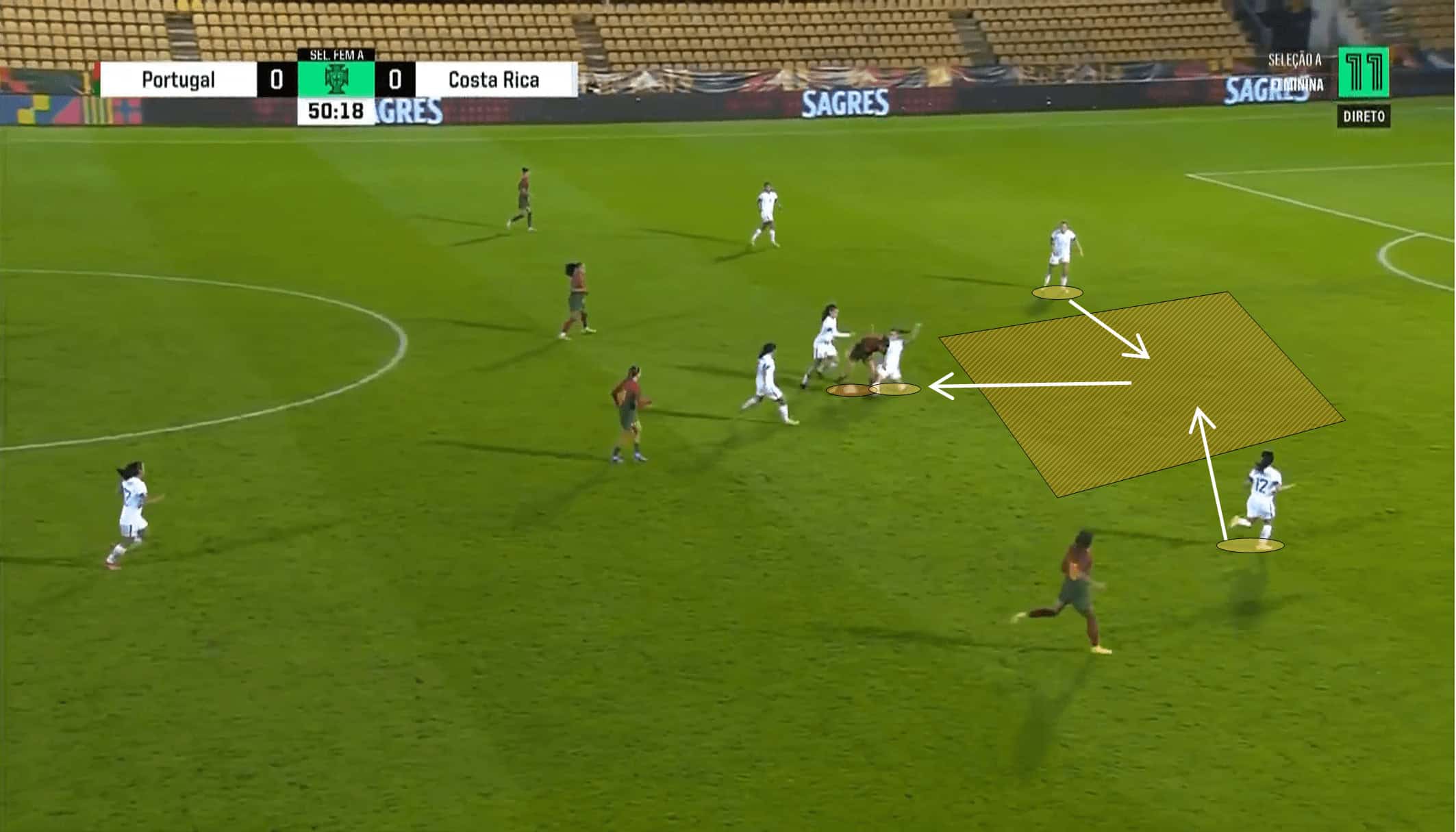
Finally, in the way we see it, one of the more negative constructive approaches that Amelia Valverde implemented is marking the opponent individually inside the box during a cross situation —be that during a set-piece or in a normal play.
We think that a less physical team would fail with this type of approach due to the fact that the attackers can easily escape their marking because of such physical advantage. Besides that, if they opt to mark zonally, the players would be better prepared to control the opponent and attack the ball.
Below, we have two images of what this individual marking inside the box looks like.
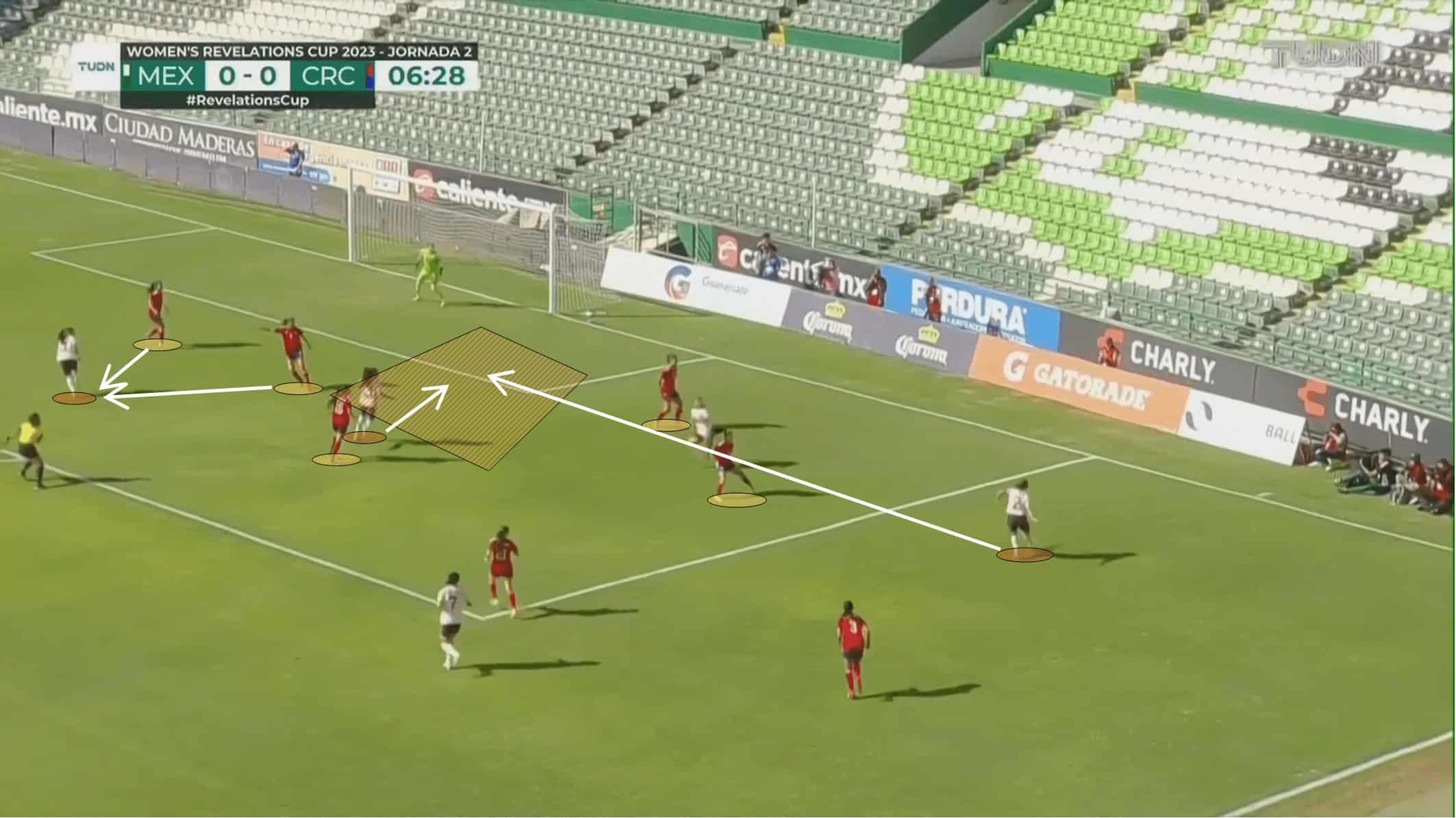
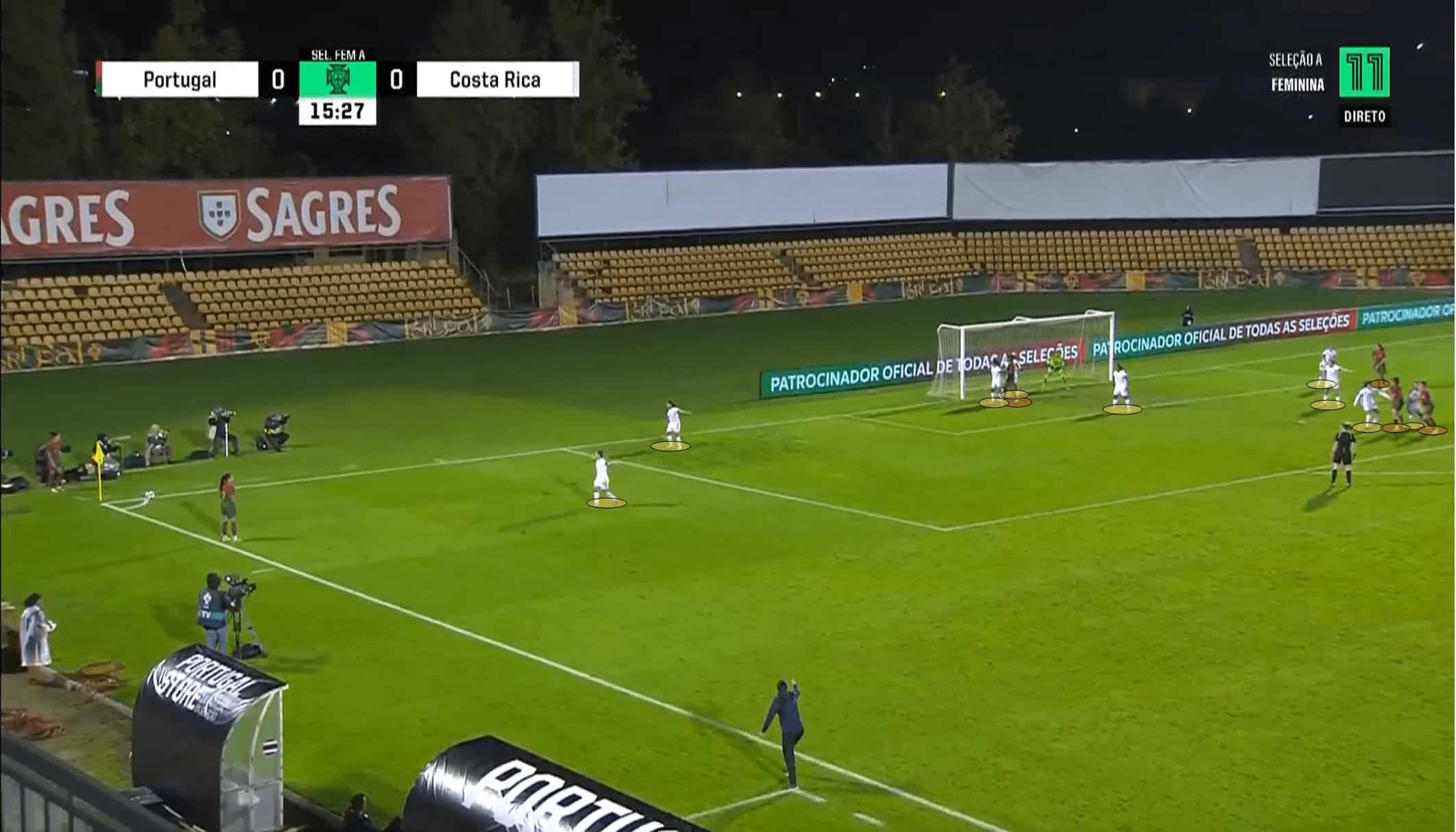
Transitions
One of Amelia Valverde’s most influential motivations to play in a 3-5-2 is most likely the prevention of the opposition’s counterattacks. Even though during their possession plan, Costa Rica’s players seek to create space by positioning deep and wide, having a backline of three plus a defensive midfielder prepared for a transition increases the odds of successfully suppressing an opposition’s counterattack.
For instance, the following image shows how Las Ticas are prepared for an eventual counterattack, with five Costa Ricans against four attackers.
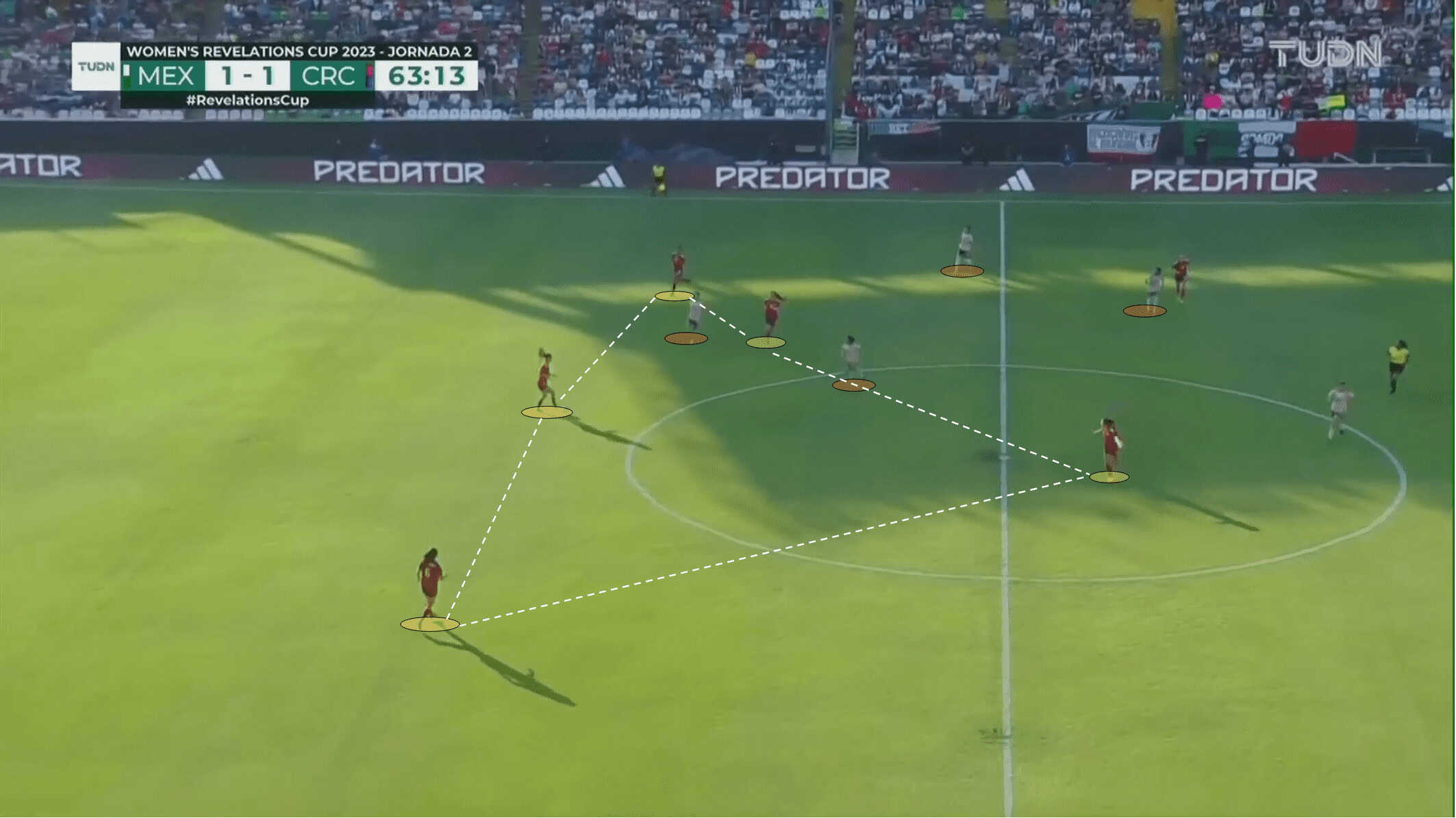
Besides that, as we can see, Las Ticas have a good reaction to win possession back, which is important to stop a possible transition.
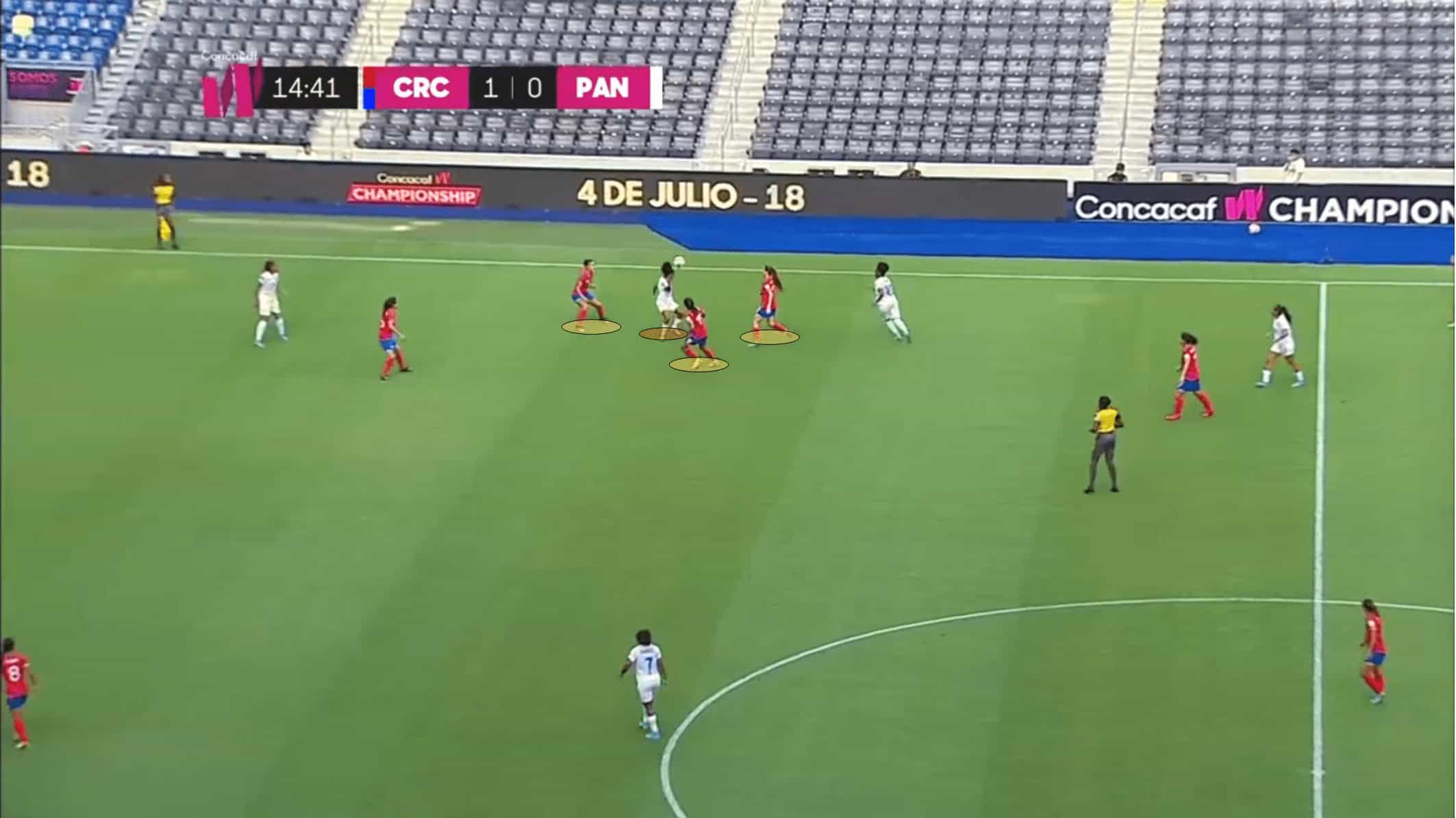
Concerning the offensive transitions, Costa Rica aren’t a very deadly team. Instead, they choose to restore their possession. As a matter of fact, referring again to Wyscout, Las Ticas on average only make 0.67 counterattacks per game, while the opposition make 2.40. In addition, 30% of Costa Rica’s counterattacks end with a shot while the other sides end with 33%.
Physical capacity, again, plays again an important role in this statistic, where the Costa Ricans, due to fatigue in some cases, are unable to support the ball carrier in such transitions. As a result, they prefer to maintain possession, rather than lose it in an inferior numeric situation.
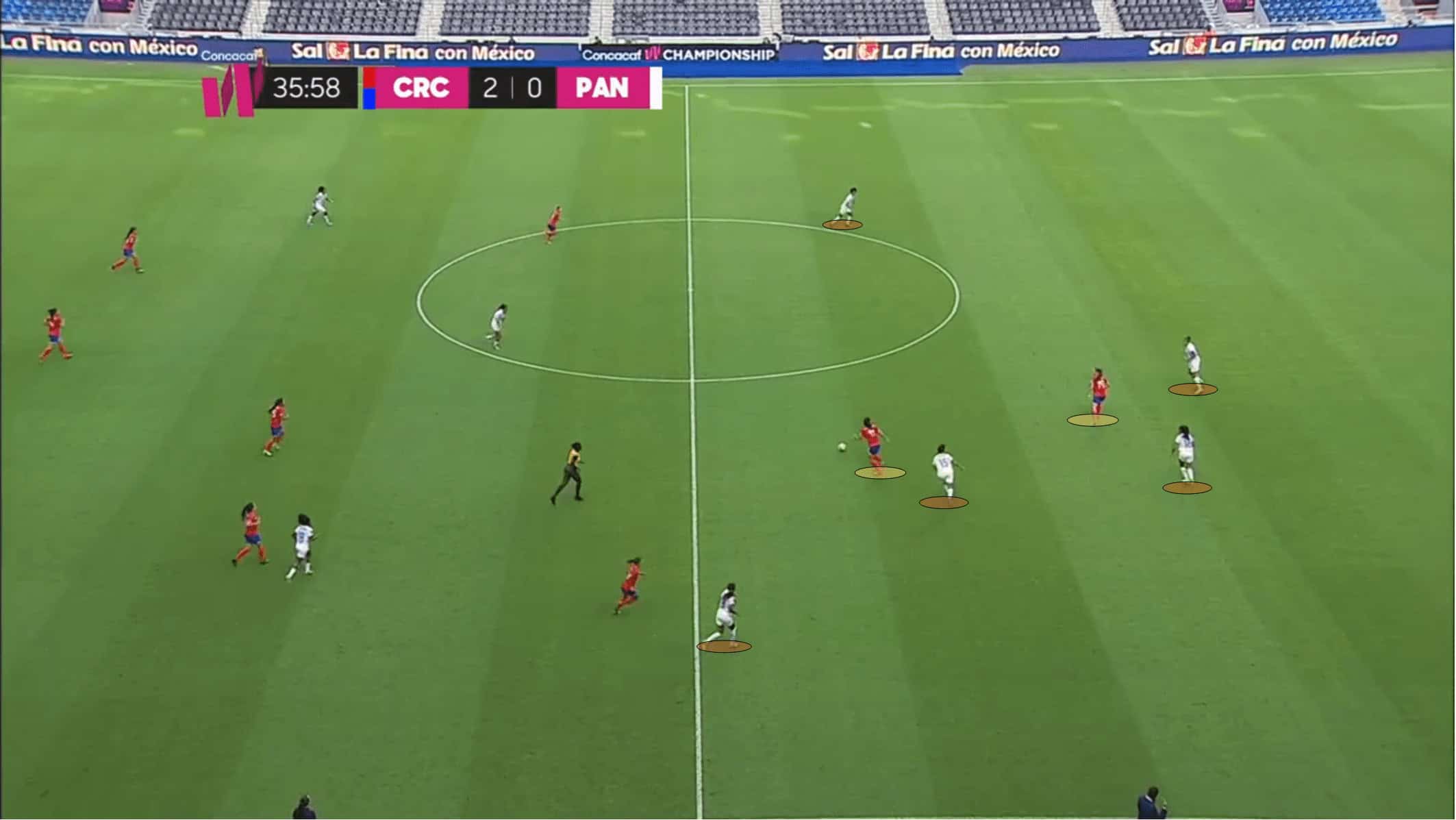

Defenders
As we previously mentioned, the three expected initial centre-backs are the ones with more minutes for the national team in recent games. However, it seems that Mariana Benavides is the one that Amelia Valverde relies on the most, due to the number of minutes played.
Concerning full-backs, Lixy Rodríguez seems to be the more capable option for the left flank due to her technique and offensive involvement. For the right side of the pitch, the competition is higher where both Daniela Cruz and Gabriela Guillén can execute their role with high quality. Yet we think that Daniela is more likely to play in the initial XI due to her tactical understanding which is visible in her versatility in different positions on the pitch.
Midfielders
Midfield is maybe the strongest sector of Costa Rica’s national team due to the quality and experience of the options. As we mentioned, we expect the deepest midfielder of Las Ticas to be Katherine Alvarado, characterised by her tactical knowledge and vision during the build-up.
Ahead of her is the experienced – and one of the most complete players of the squad — Cristin Granados, who is strong in build-up, versatile, has a good vision and decent technique, allowing her to take corners or even free kicks. Raquel Rodríguez is the third and final element of the midfield; she is instructed to play slightly ahead of Granados due to her final third good involvement. In fact, with 55 goals at just 29 years old, Raquel became her country’s top goalscorer — it is normal to see her presence in the area even if she is playing as a midfielder.
It is also important to explain that players like Melissa Herrera and Gloriana Villalobos are elements that can have a significant positive impact when they eventually come off the bench.
Attackers
The front two attackers will most likely be composed of two centre-forwards, one more advanced and one deeper who will support the most advanced element by exploring the space between the lines.
We anticipate Carolina Venegas to be the more advanced player due to her ability to play with her back turned to the opposition’s goal and also due to her experience in big international competitions. Yet, the 20-year-old María Paula Salas is also a decent alternative to the attack. Right behind her, we foresee Priscila Chinchilla to be the element chosen by Amelia Valverde.
Key Player
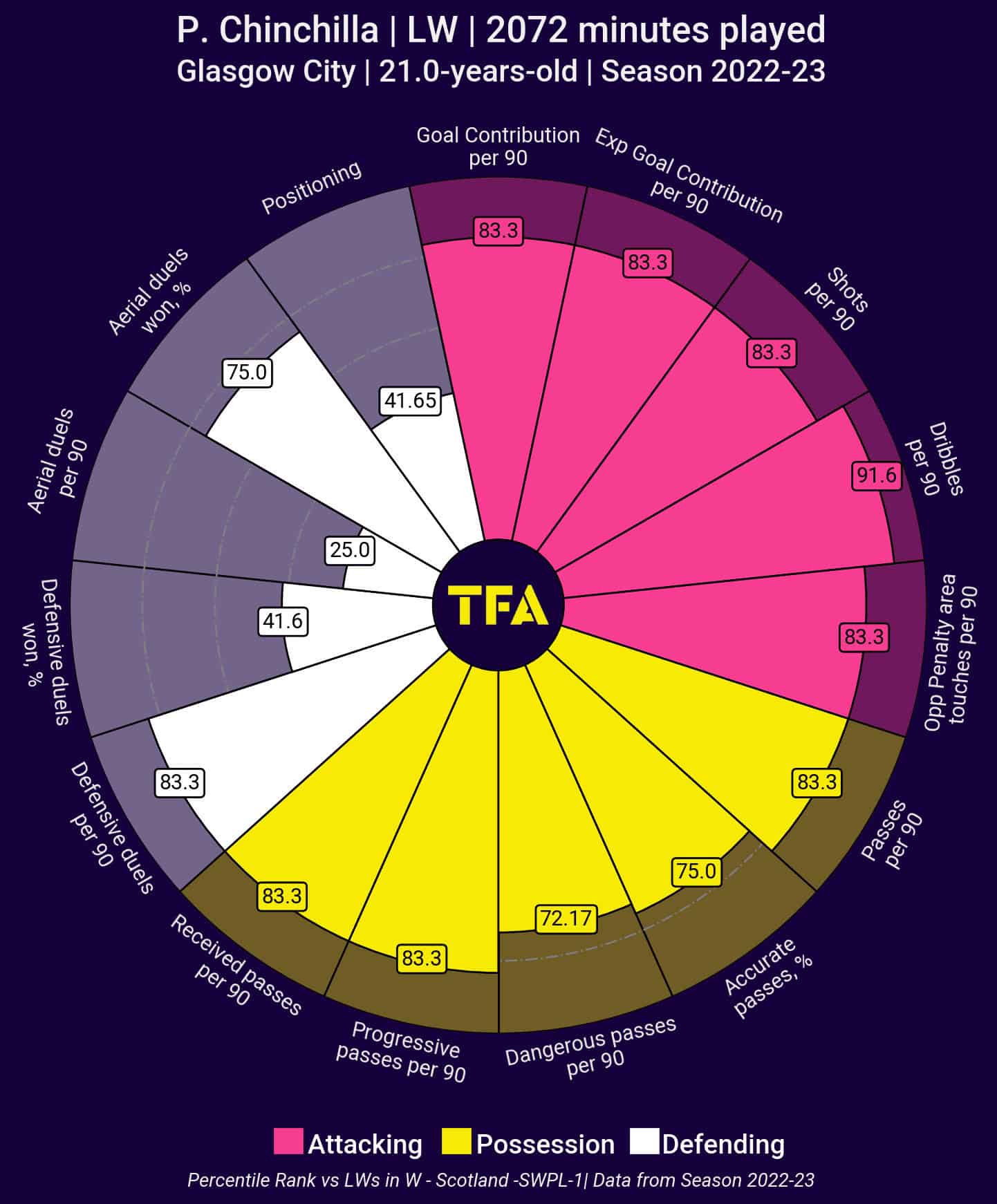
At just 21 years old, Priscila Chinchilla is becoming one of the main figures of her club, Glasgow City, and this season scored 14 goals. She isn’t tall and has some difficulties in aerial duels. In fact, according to the above radar she ranks in the 25th percentile in these types of scenarios. Yet, physically, she is very agile, explosive and capable of handling the opposition’s charge.
Additionally, she is technically gifted and particularly strong in her dribble where she feels comfortable facing her opponent in the 1v1. The data validates such attributes where Priscila is ranked in the 91.6 percentile for dribbles per 90 minutes.
Chinchilla is a player with a high offensive involvement and has particular importance in creating goal opportunities for her team. In fact, she ranks 83.3 percentile in shots per 90 minutes and in both expected and effective goal contributions per game.
We foresee Priscila to be one of the main figures in the short and long run for Costa Rica women’s football.
Tournament Prediction
With fewer individual stars compared with the Spanish and Japanese sides, Costa Rica will have a tough task to succeed and pass to the knockout stage. Besides that, FIFA took down the possibility to pass via third place, making the challenge even more difficult.
However, the head coach Amelia Valverde seems like a woman determined to take Costa Rica’s national team to a higher level over the years. In this way, we will expect a very combative team who will not submit to any side no matter how good they are. In our opinion, we think that the second place is a possibility for Las Ticas.






Comments